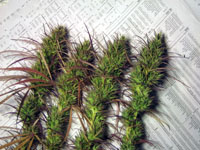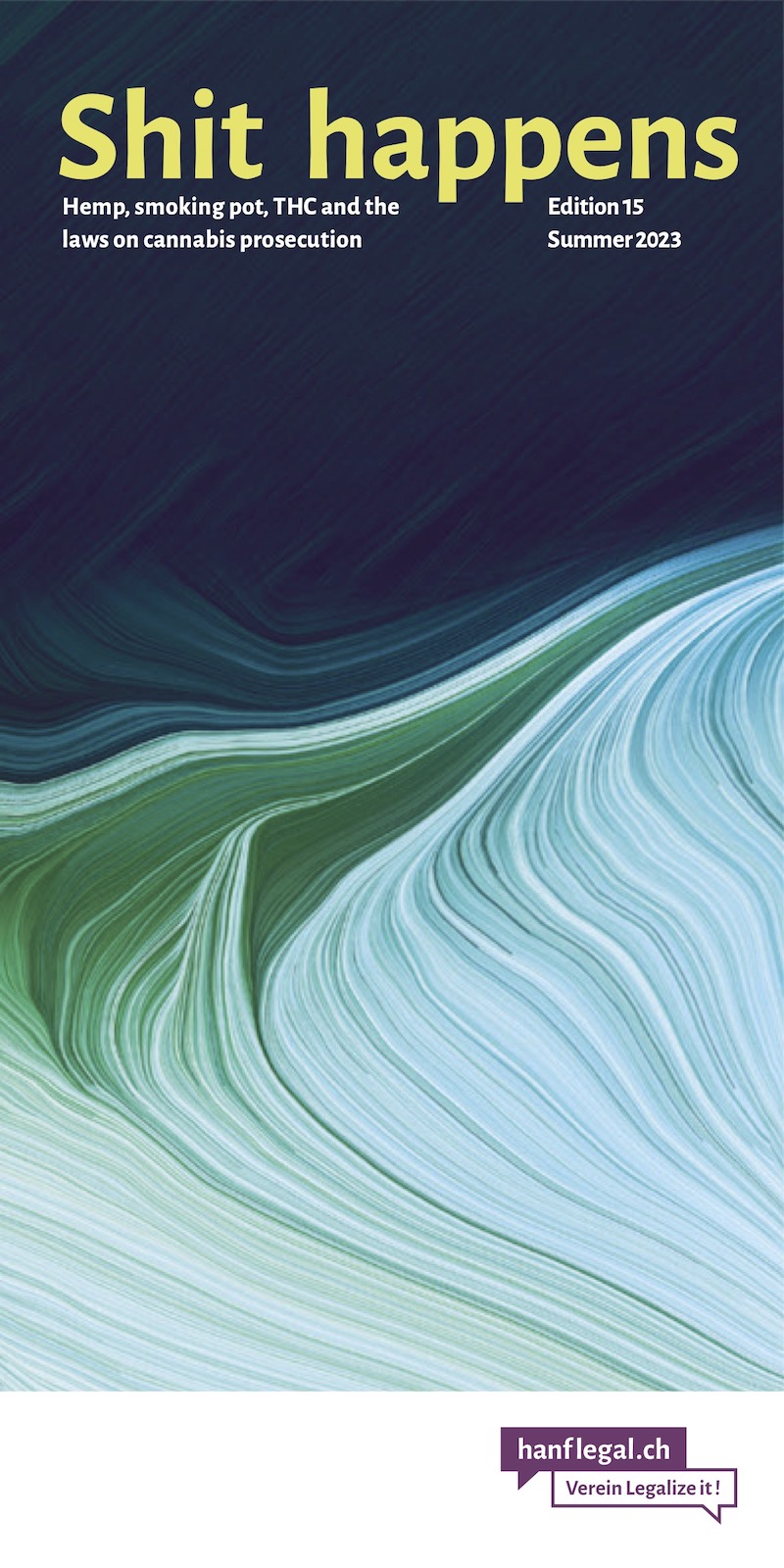- THC & Law:
Cannabis as medicine: dronabinol and marinol
Most people know cannabis as a stimulant. But for centuries, hemp has also been used for medicinal purposes. Currently, some countries are loosening the law regarding the medical use of cannabis products. Also in the partial revision of NarcA in Switzerland, which will be implemented in 2011, an improvement of the legal situation regarding the medical use of THC is foreseen. Therefore, this article aims to provide an overview of medical uses as well as the necessary background knowledge.
Effective ingredients
Around 500 ingredients of the cannabis plant have been discovered so far. Many of them are also found in other plants and even in animals. However, they usually have little or no pharmacological effect. A part of these ingredients are the cannabinoids. Almost 70 of them have been identified in the hemp plant to date. They can be divided into ten groups according to their chemical structure. Two important ones are the cannabinoids of the delta-9-THC type and the cannabidiol type. The delta-9-THC group includes a total of nine cannabinoids.
Often, only three to four cannabinoids are found in relevant concentrations in a plant. In cannabis that is processed into marijuana or hashish, it is mainly the delta-9-THC that occurs in high concentrations (approx. 1 to 25%). In fiber hemp, on the other hand, the cannabidiol predominates.
Delta-9-tetrahydrocannabinol (THC) is responsible for the known psychic but also many medicinal effects. It has mood-lifting, muscle-relaxing, anti-epileptic, anti-nausea, appetite-increasing, antibiotic, fever-reducing, intraocular pressure-lowering, bronchodilator, sedative and pain-relieving effects.
Cannabidiol does not exhibit any psychic effects. On the contrary, in high enough doses it even counteracts the psychic effects of THC. It also has sedative, anti-inflammatory, anti-epileptic, anxiolytic (anti-anxiety), anti-psychotic effects and also lowers intraocular pressure.
Delta-9-THC and cannabidiol are two of the most important pharmacological constituents of the cannabis plant. However, there are also other substances that can be used medicinally, including certain essential oils and some flavonoids.
Effect of cannabinoids in the body
The cannabis active substances produced by the body itself, so-called endocannabinoids, act in the human body in a similar way to the ingredients of cannabis, although the time of action is shorter. In 1992, the first endogenous cannabinoid was discovered, called anandamide. It is derived from the Sanskrit word ananda, meaning bliss, and amide, which describes its chemical structure. The endocannabinoids, together with the cannabinoid receptors, form the body's cannabinoid system. This is responsible for a number of functions such as the regulation of appetite, the perception of sensory impressions and pain or the coordination of movement.
Cannabinoid receptors are found not only in the brain and spinal cord, but also on many other cells such as cells of the heart, intestines, lungs, urinary tract, uterus, testes, internal glands, spleen, blood vessels and white blood cells.
Endocannabinoids are among the most important inhibitory messenger substances. They also affect a variety of other neurotransmitters - including GABA, glutamate, glycine, norepinephrine, serotonin, dopamine, acetylcholine, and neuropeptides (enkephalins, endorphins). Many of the medicinal effects of cannabis are due to interactions with these neurotransmitters.
The endocannabinoid system is not a fixed quantity. It changes in some physical diseases. This can affect both the amount of cannabinoids and the receptors. For example, in pain disorders, the amount of anandamide increases in some brain regions to relieve pain. Thus, the cannabinoid system adjusts in response to pathological changes to rebalance the disorder.
In addition to cannabinoid receptor effects, however, there are other mechanisms by which cannabinoids can exert their effects. It is known that cannabinoids, like vitamins C and E, can scavenge free radicals and thus prevent cell damage. Some degradation products also exhibit healing properties. For example, the THC-carboxylic acid (THC-COOH). This is the substance that is detected in urine when cannabis use is suspected. It has similar properties to aspirin, i.e. it has an anti-inflammatory and pain-relieving effect.
Fields of application
There is a whole range of possible medical disorders for which cannabis can be used (see green box). However, there are already proven medications for all of these disorders. However, these do not work for all patients or cause severe side effects in some. For example, opiates (morphine) can cause nausea or constipation. Therefore, cannabis preparations are often used together with other medications so that its dose can be reduced. In the case of the above-mentioned opiates, their analgesic effects are enhanced by dronabinol. In addition, dronabinol counteracts the nausea that can be triggered by morphine. However, not all drug combinations are useful (see article in the next Legalize it!). However, serious or even life-threatening interactions are not described for cannabis. Single doses of 2.5 to 15mg THC are often used. The effect lasts between 3 to 12 hours, which means that cannabis preparations have to be used 2 to 4 times a day.
Multiple effects
In most cases, cannabis acts not only on a single symptom, but on several symptoms at the same time. For example, AIDS patients benefit from the anxiety, pain and nausea reducing effect as well as from the appetite increasing effect. Despite the large number of possible applications, only three indications have been accepted by regulatory authorities worldwide to date. In the U.S., Marinol is used to treat nausea and vomiting during cancer chemotherapy and to treat loss of appetite in AIDS patients. In Canada, Sativex (cannabis extract in spray form) is used to treat neuropathic pain in multiple sclerosis. In other countries, dronabinol/THC is not approved as a medicine for specific conditions, but may be prescribed by a physician.
Legal situation
Provided that a psychological effect can be excluded, the medicinal use of hemp/THC is permissible. The purely medicinal use of cannabis is often tolerated. Dronabinol may be used with a permit from the health authorities. In 2011, there will be a partial revision of the NarcA, in which the medical use of hemp products will also be newly regulated. However, the details are currently (2010) still open.
Addresses and sources of supply
ACM and IACM website: www.cannabis-med.org, e-mail: info@cannabis-med.org; contact Switzerland: Dr. pharm. Manfred Fankhauser, Bahnhof Apotheke, Dorfstrasse 2, 3550 Langnau, phone 034 402 12 55
Definitions and explanations
Cannabinoids: These are the actual ingredients of the hemp plant. At the moment, about 66 specific cannabinoids are known.
Cannabinoid receptor: These are specific binding sites in various body cells to which endocannabinoids or plant cannabinoids bind and exert their effects.
Delta-9-THC: The pharmacologically most important cannabinoid. It is responsible for most of the medicinal effects. THC stands for tetrahydrocannabinol. Another name for it is dronabinol.
Dronabinol: Another name for the naturally occurring delta-9-THC. In Germany and Austria, it may be prescribed on a narcotic prescription. In Switzerland, an authorization is given by Swissmedic in special cases.
Endocannabinoid: The cannabinoids produced by the body itself (endogenous). They act similarly to the exogenously supplied cannabinoids of the hemp plant.
Marinol: A synthetically produced dronabinol preparation in capsule form. Marinol may be imported from the USA in Germany.
List previous potential uses of cannabis/THC:
| Nausea and vomiting: | Cancer chemotherapy, HIV/AIDS, hepatitis C, pregnancy vomiting, nausea in migraine. |
|---|---|
| Loss of appetite and emaciation: | HIV/AIDS, cancer, hepatitis C |
| Spasticity: | Muscle spasms and stiffness, multiple sclerosis, paraplegia, spasticity after stroke, tension headaches, tension of the back muscles |
| Movement disorders: | Tourette's syndrome, dystonia, certain dyskinesias in Parkinson's disease and schizophrenia. |
| Pain: | Migraine, cluster headache, phantom pain, neuralgia (nerve pain), menstrual cramps, paresthesias (tingling, formication) in diabetes or AIDS, hyperalgesia, pain due to tense muscles or muscle spasms, osteoarthritis, arthritis, ulcerative colitis, restless legs syndrome, fibromyalgia |
| Allergies: | Asthma, dust allergies, hay fever |
| Itching: | Itching in liver diseases, neurodermatitis |
| Inflammation: | Asthma, arthritis, ulcerative colitis, Crohn's disease, neurodermatitis |
| Mental illness: | Depression, anxiety disorders, bipolar disorder, post-traumatic stress disorder, hyperactivity, ADHD, impotence, alcoholism, opiate addiction, sleeping pill addiction, insomnia, autism, confused behavior in Alzheimer's disease. |
| Overproduction of gastric acid: | Gastritis |
| Increased intraocular pressure: | Glaucoma (green star) |
| Dilatation of the bronchi: | Asthma, shortness of breath with other respiratory diseases |
| Other diseases: | Epilepsy, promotion of labor during childbirth, hiccups, hypertension, tinnitus (ringing in the ears). |
Support our work with a donation:
Bank transfer
Account number (IBAN):
CH02 0900 0000 8709 1354 3
Full account details
Or scan this QR code with your eBanking App (ZKB, Revolut, Postfinance, …):

Or open/share the QR code as PDF file with your eBanking App.
Credit card
Donate via credit card
Verein Legalize it!
Quellenstrasse 25
8005 Zürich
Threema ID 7NH65RBY
Don’t miss anything! Follow us on social media:

